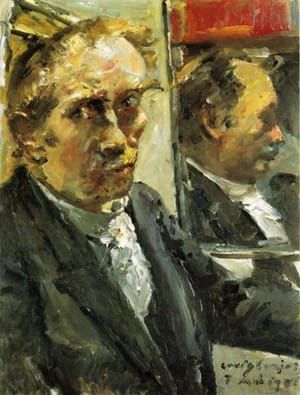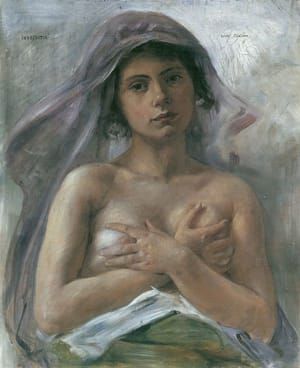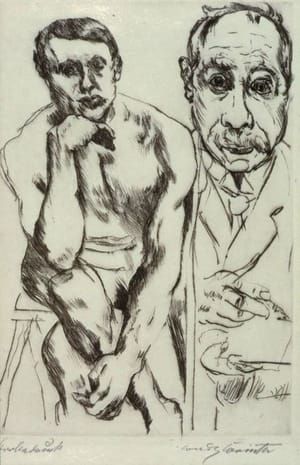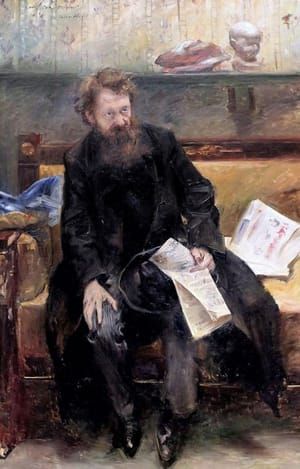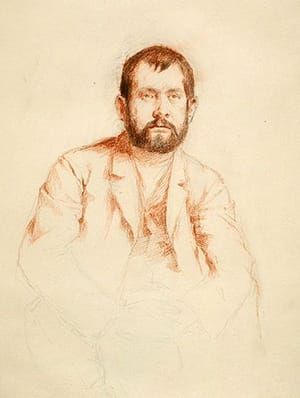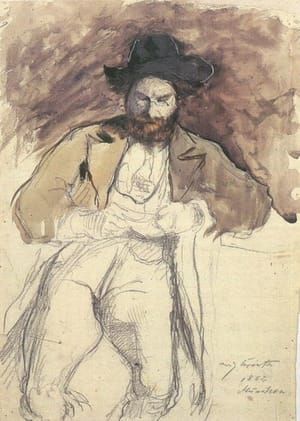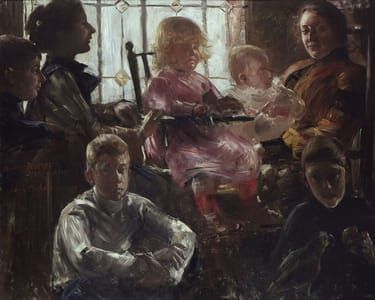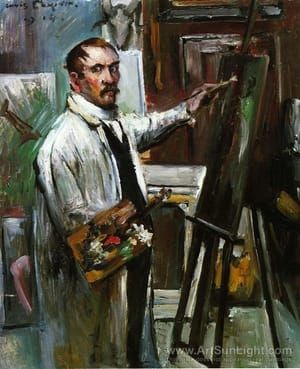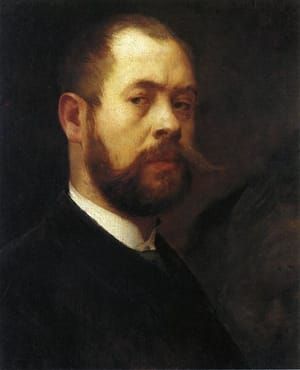

Death and the Artist (Tod und Künstler) from Dance of Death (Totentanz), 1921
Lovis Corinth
(1921, published 1922)
In Totentanz (Dance of death) Lovis Corinth modernizes a theme that German printmakers had explored since the 16th century, the inevitability of death. Corinth made these five prints in the last years of his life. Depicting a skeletal figure visiting him, his friends, and his family, the artist personalized the experience of dying. The portfolio exemplifies the highly expressionistic style he developed after having a stroke in 1911.
In the opening print, Tod und Künstler (Death and the Artist), Death looms over and trains his empty eye sockets on Corinth, who looks up, knowingly, from the print he is etching. On Corinth's wrist, evoking the ceaseless passage of time, is a watch given to him by his beloved wife, Charlotte, who herself appears in Tod und Weib (Death and the Woman), cradling Death in her arms. Death looks small and fragile next to Corinth's teenage son in Tod und Jüngling (Death and the Youth), unlike the robust figure who casts an ominous shadow over the artist's father in Tod und Greis (Death and the Old Man). The final print shows the artist Hermann Struck—who had tutored Corinth in printmaking and encouraged him to explore drypoint and the other techniques used in these prints—and his wife, Mally, confronting Death together.
[https://www.moma.org/s/ge/collection_ge/object/object_objid-66892.html]
...Look at Lovis Corinth. Painters don't only have eyesight that can go wrong. They have hands too. And in 1911, in his early fifties, Corinth had a stroke. He recovered from it, and lived almost another 15 years. But his work never forgot it. After that, his painting has the shakes.
...But Corinth himself certainly connected this kind of handi work with the fate of his body.
There's a small etching that tells the story. Death and the Artist is a self portrait showing the artist at work, in the middle of drawing, looking up for a moment from his sheet to check his likeness, staring hard out towards us, at a mirror in front of him, before going back to add more lines. It's an idea used by Rembrandt. It shows the momentary pause, the tension of intense, short-burst looking, the hand waiting to get to work again. It involves the viewer closely in the making of the image - the image, of course, at which we now happen to be looking.
Except that Death is present too. A skeleton figure stands behind the artist, appearing over his shoulder, and stretching out a bony arm to grip his drawing arm, to joggle it impatiently. "Come on, hurry up, finish up, I haven't got all day, we're going": that's what Death's gesture says, and the artist's face shows a look that answers, cross but resolute, holding its concentration steadily against the interruption and the pressure: "just let me do this, if you'll just hold on for two minutes..." at which point you notice the effect of Death's impatient joggling hand on the artist's drawing arm, and of the artist's attempt to work on in spite of this impediment. All the lines of the etching are scratchy, joggly, shaky. The etching is a style-statement. It is the physical pressure of death, and the resistance to this pressure, that creates the graphic character of the image. It is a lateish work. Two years later, very near the end, there is the Last Self Portrait.
[http://www.independent.co.uk/arts-entertainment/art/great-works/corinth-lovis-last-self-portrait-1925-795452.html]
Uploaded on Feb 19, 2018 by Suzan Hamer
Lovis Corinth
artistArthur
Wait what?
